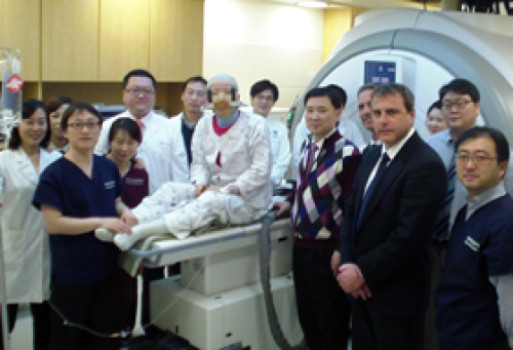
A recently published report in the Journal of Molecular Psychiatry supports the potential of focused ultrasound to treat certain patients with obsessive-compulsive disorder (OCD).
In a study of feasibility, safety and preliminary efficacy, four patients with disabling OCD unresponsive to medical therapy were treated by ablating small targets deep in the brain (anterior internal capsule) using the InSightec ExAblate Neuro MR-guided focused ultrasound system. This proof-of-concept study is being conducted with 12 patients by Jin Woo Chang, MD, PhD, at the Yonsei University Medical Center in Seoul, Korea. The results of the first four patients with six months follow-up were published.
All four patients had the targeted areas of the brain successfully ablated. The procedures were accomplished without complications or side effects and resulted in gradual improvement in obsessive-compulsive thoughts and behaviors as well as showing the nearly immediate and sustained improvement in depression and anxiety over six months.
“There is a need for non-invasive treatment options for patients with OCD that cannot be managed through medication,” says Dr. Chang. “Using focused ultrasound, we were able to reduce the symptoms for these patients and help them get some of their life back without the risks or complications of the more invasive surgical approaches that are currently available.”
“If these initial results are confirmed in the remaining eight patients in this study as well as in a larger pivotal trial of safety and efficacy, focused ultrasound could emerge as an alternative to surgery for improving quality of life in a cost-effective manner for patients with OCD,” said Foundation Chairman Neal F. Kassell, MD. “This could also serve as the predicate for non-invasive therapy for other psychiatric disorders.”
Dr. Chang plans to start a study using focused ultrasound to treat depression in 2015.
Current Treatment for OCD
Obsessive-compulsive disorder (OCD) is a psychiatric disorder characterized by recurring anxiety-provoking thoughts (obsessions) that are alleviated only by ritualistic actions (compulsions) such as hand washing. OCD symptoms can be overwhelming and result in severe impairment and dysfunction. Patients also have a high risk for depression, with two-thirds of OCD patients developing major depression.
Although a large portion of OCD patients improve with drug therapy, some patients have debilitating symptoms that are resistant to treatment. For these patients, psychosurgery can be performed to destroy (ablate) a targeted region of the brain (anterior internal capsule) associated with the disorder. The currently available ablative approaches are invasive or involve radiation:
• Radiofrequency ablation requires drilling into the skull and inserting a probe through the brain.
• Stereotactic radiosurgery takes months to achieve an effect and may be associated with side effects of radiation.
• Deep brain stimulation has been used as a reversible and adjustable alternative to ablation, but it involves the risks and complications of surgery to implant the system and additional operations for battery changes.
Story Source:
The above story is based on materials provided by Focused Ultrasound Foundation. Note: Materials may be edited for content and length.
Journal Reference:
- H H Jung, S J Kim, D Roh, J G Chang, W S Chang, E J Kweon, C-H Kim, J W Chang. Bilateral thermal capsulotomy with MR-guided focused ultrasound for patients with treatment-refractory obsessive-compulsive disorder: a proof-of-concept study. Molecular Psychiatry, 2014; DOI: 10.1038/mp.2014.154
